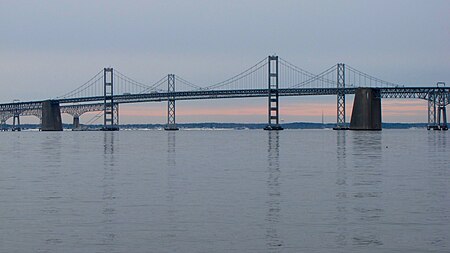Chesapeake Bay Bridge

The Chesapeake Bay Bridge (also known locally as the Bay Bridge) is a major dual-span bridge in the U.S. state of Maryland. Spanning the Chesapeake Bay, it connects the state's rural Eastern Shore region with the urban Western Shore, between Stevensville and the capital city of Annapolis. The original span, opened in 1952 and with a length of 4.3 miles (6.9 km), was the world's longest continuous over-water steel structure. The parallel span was added in 1973. The bridge is officially named the Gov. William Preston Lane Jr. Memorial Bridge after William Preston Lane Jr. who, as the 52nd Governor of Maryland, initiated its construction in the late 1940s finally after decades of political indecision and public controversy. The bridge is part of U.S. Route 50 (US 50) and US 301, and serves as a vital link in both routes. As part of cross-country US 50, it connects the Baltimore–Washington Metropolitan Area with Ocean City, Maryland, Rehoboth Beach, Delaware, and other coastal tourist resort destinations. As part of US 301, it serves as part of an alternative route for Interstate 95 travelers, between northern Delaware and the Washington, D.C., area. Because of this linkage, the bridge is busy and has become known as a point of traffic congestion, particularly during peak hours and summer months. The bridge's role in transportation was filled by ferries prior to the first span's construction. An annual 10K run across the bridge has been organized on-and-off since 1975. The bridge's economic impact on the areas it connects has been significant, with both Queen Anne's County and Ocean City expanding significantly since the bridge's construction. Future expansion of the bridge has been discussed since 2004, with a task force being formed to investigate the possibility of building a third span. Because of similar names, it is often confused with the Chesapeake Bay Bridge–Tunnel, a bridge–tunnel linking the Eastern Shore of Virginia with the Hampton Roads region and the rest of Virginia.
Excerpt from the Wikipedia article Chesapeake Bay Bridge (License: CC BY-SA 3.0, Authors, Images).Chesapeake Bay Bridge
Chesapeake Bay Bridge,
Geographical coordinates (GPS) Address External links Nearby Places Show on map
Geographical coordinates (GPS)
| Latitude | Longitude |
|---|---|
| N 38.991666666667 ° | E -76.372222222222 ° |
Address
Chesapeake Bay Bridge (William Preston Lane, Jr. Memorial Bridge)
Chesapeake Bay Bridge
21666
Maryland, United States
Open on Google Maps







